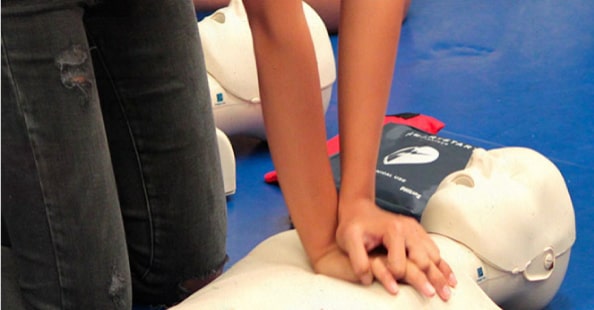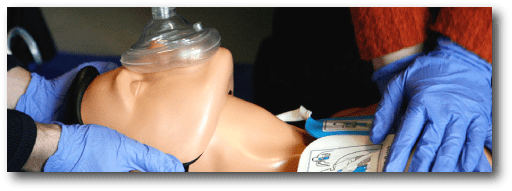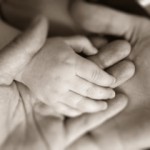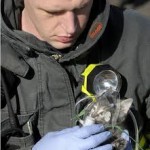CPR TRAINING
FOR EVERY ONE

Why It Is Important
When someone goes into sudden cardiac arrest or suers a heart attack, would you know what to do? Unfortunately, many of us do not think of what we would do in an emergency until one happens. Cardiopulmonary resuscitation (CPR) is often the dierence between life or death in these situations, and yet, most Americans do not know how to perform CPR. Thousands of lives could be saved each year if more people were trained in CPR and didn’t hesitate to perform it on others. Because of this, it is important that everyone understands how to administer CPR and feel con-dent in their abilities.
CPR: The Basics
Understanding what CPR is and when it is used is a good rst step when it comes to saving lives. Even those who do not have CPR training may nd themselves in a situation that requires them to attempt CPR. Here are some basics that you need to know:
What is CPR?
Cardiopulmonary resuscitation, or CPR, is a rst aid technique used to help someone who is not breathing or their heart has stopped. It involves using chest compressions and rescue breaths to help keep oxygen and blood circulating in the body. While many people who need CPR are experiencing issues with their heart, CPR is actually more concerned with the brain. This is because the heart can survive for longer than the brain without oxygen-rich blood. Brain cells will begin to die within six minutes if oxygen and blood carrying nutrients are not delivered to it.
This is why it is crucial to perform CPR in addition to using an automated external debrillator (AED) to revive victims of cardiac arrest.
Chest compressions

Chest compressions are given by placing the heel of the respondent’s hand on the center of the victim’s chest and placing the other hand on top. The respondent will then press down on the chest at a depth of about two inches and give 100 compressions per minute. Chest compressions attempt to mimic the heart and get blood owing through the body once again.
Rescue breaths
Rescue breaths also play an important role in CPR. Rescue breaths are given by tilting the victim’s head back a certain amount (depending on the age of the victim) to clear the airway. Two rescue breaths will be given after every cycle of 30 compressions.

As of 2015, the American Heart Association has issued guidelines recommending hands-only CPR for those who are not trained to give CPR. This will hopefully encourage more bystanders to deliver CPR to those who need it and buy them time before an emergency medical response team can arrive to help.
When is CPR Used?
Tragedy can strike anywhere at any time and CPR is frequently used for many dierent emergencies. Some of the life-threatening situations requiring CPR include:
Cardiac Arrest:

Cardiac arrest is one of the leading causes of death in the United States and occurs when the hear t suddenly stops beating. The victim will suddenly collapse and will require CPR and the use of an AED to be revived. The survival rate of out-of-hospital cardiac arrest victims is low, with a meager eight percent of victims surviving the attack. Nearly half of these attacks are witnessed by others who may be too afraid to act or simply not know what to do.
Heart Attacks:

When the blood ow is suddenly unable to ow to the heart, the heart can no longer get oxygen and if not treated quickly, portions of the heart
muscle begin to die. Symptoms of heart attacks in men and women include chest discomfort, shortness of breath, and sudden weakness. Anyone
experiencing these symptoms needs to call 911 immediately. However, there are times when the victim may fall unconscious and you may need to perform CPR on them. Performing CPR on them could help keep them alive until a medical team arrives.
Choking:

When the blood ow is suddenly unable to ow to the heart, the heart can no longer get oxygen and if not treated quickly, portions of the heart muscle begin to die. Symptoms of heart attacks in men and women include chest discomfort, shortness of breath, and sudden weakness. Anyone experiencing these symptoms needs to call 911 immediately. However, there are times when the victim may fall unconscious and you may need to perform CPR on them. Performing CPR on them could help keep them alive until a medical team arrives.
Drowning:

According to the Centers for Disease Control and Prevention (CDC), about ten people die each day from unintentional drowning and it is ranked fth among the leading causes of unintentional injury death in the United States. CPR is critical in drowning accidents where the victim is not breathing and every second counts. The longer that CPR is delayed, the less chance of survival the drowning victim has.
Drug Overdose:

Drug overdoses can cause people to suer respiratory failure and cardiac arrest. When this occurs, their survival will depend on their ability to be resuscitated. According to the CDC, 44 people die in the U.S. every day from overdose of prescription paink illers. Being equipped with the knowledge to help can potentially save people from such tragedies.
Who Should Learn CPR?

Short answer—everyone. Many professions require regular CPR training, such as nurses, reghters, police ocers, and paramedics. However, even those who do not have a job that requires them to learn CPR should take a course. While emergency situations are not uncommon, they are also not a daily occurrence in everyone’s lives and are therefore not given much thought before they happen. When emergencies do happen, they can be frightening, especially if you don’t have any idea what steps to take. A person is much less likely to panic in an emergency if they have been trained on recognizing emergencies and how to respond to them.
Learning CPR isn’t only for adults either. Studies show that CPR training can begin as early as age nine and largely depends on the child’s body mass. A child can retain the information as well as an adult and this knowledge can be supremely benecial. Even if a child cannot perform CPR, it is still benecial for them to understand what to do in an emergency. Just by knowing to alert emergency medical services can dramatically increase the chances of survival.
The Importance of CPR
Every year, almost 350,000 Americans die from heart disease. At least half of these will occur outside of a hospital and anyone who witnesses the emergency needs to
respond quickly. The fact is that we can’t predict when emergencies will happen, but we can prepare ourselves as best as we can in order to give our loved ones the best chances of survival. Learning CPR is important for people of all walks of life so that we can save more lives each and every year.
The Facts on Heart Disease

According to the CDC, heart disease is the number one killer in the United States each year. That should be a huge concern for many
who have a family histor y of hear t conditions. As the leading cause of death for both men and women, heart disease is common and we all
need to be prepared for emergencies involving this disease. Taking early action for heart attacks, strokes, and cardiac arrest victims is critical
for increasing the chances of survival. Many people have suered from cardiovascular problems even when their family history revealed no signs of heart problems. This is why it is important that we all receive the necessary training to recognize signs of heart disease and prepared for when tragedies occur.
Why We Need to Stop Hesitating
Chances are high that if you need to perform CPR on someone, it will be for family or close friends in their homes. However, this doesn’t mean that you shouldn’t be prepared to perform it on a stranger if the need arises. According to the American Heart Association (AHA), bystanders performing CPR on cardiac arrest victims can double or even triple their chances of survival, but only 32 percent receive CPR from a bystander. So why less than one-third of bystanders taking action? Bystanders can be hesitant of performing CPR for a number of reasons:
Fear of being sued:
One reason why some hesitate to perform CPR is the fear of being sued. While it is true that the United States has a reputation for ling a large amount of lawsuits, the fear of being sued for attempting CPR is unfounded. This is because every state has Good Samaritan laws that oer some sort of protection for those attempting to help others that are injured or in danger. These laws vary from state to state, but there has never been a case successfully won in which a person was sued for attempting to save someone’s life with CPR.
Lack of knowledge on CPR technique:
Another reason why bystanders may hesitate is because they are not condent in their abilities to administer CPR. They fear that they will end up hurting the victim or performing CPR incorrectly. As a way to combat this thinking, the AHA has issued new guidelines that encourage bystanders to give hands-only CPR (no rescue breaths). Chest compressions have been found to be successful even without rescue breaths and this also makes bystanders more likely to perform CPR on those who need it. Those who do not have the proper CPR training need to take action. It cannot be stressed enough that untrained CPR is better than no CPR at all.
Panic takes over:
Some people can naturally keep a cool head when emergencies occur. Others may panic and not think logically. CPR training can boost a person’s condence when it comes to dealing with emergency situations and allow them to stay calm under pressure. Bystander intervention can make the dierence between life and death for someone, so it is crucial that we overcome this fear and take action.
Why Everyone Should
Become CPR Certified
The prospect of performing CPR on someone may seem daunting, but it doesn’t have to be. Becoming trained in CPR will help you overcome a lot of anxiety that surrounds emergency situations.
How Do I Get CPR Certied?

Becoming CPR cer tied is not dicult. Places such as SimpleCPR oer training courses online that have been accredited by the American Health Association and that make it easy to become CPR certied. Some places of work even oer courses to their employees to make their workplace safer.
The Benefits of CPR Training
The amount of benets that CPR training can provide may surprise you. In addition to being able to save countless numbers of lives, CPR training can also provide these benets:
Protecting loved ones:

Chances are high that if you need to perform CPR on someone, it will likely be that of your family or close friends. Knowing that you can perform CPR on your family can give you peace of mind.
Employment:

Having CPR certication looks great on a resume and many places will consider those with CPR certication rst. This is because it demonstrates that you can successfully complete a training course and also that you can make the workplace a safer place for all.
Boost of condence:

Learning a skill like CPR can be a huge condence booster. Just having the ability to save a life can give you a sense of security.
CPR Saves Lives

CPR training is extremely important and it is a life-saving technique that everyone should know. With more people undergoing CPR training, we have the potential to save thousands of lives. The fact of the matter is that the life you save will most likely be that of someone you know.
In order to protect your loved ones, everyone should receive CPR training. With the ability to get CPR certied online, there is no better time to learn than right now.




